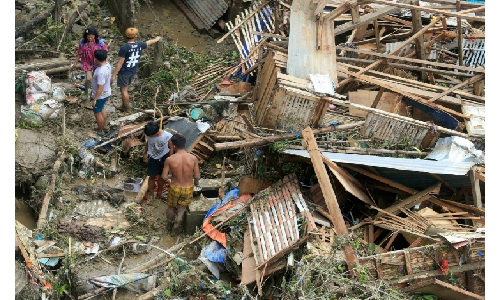‘Complete carnage’: Hundreds dead in typhoon-hit Philippines
Agencies | Manila
The Daily Tribune – www.newsofbahrain.com
The death toll from Typhoon Rai has surpassed 200 in the Philippines, with humanitarian workers reporting “complete carnage” in coastal areas where they said the storm had left homes, hospitals and schools “ripped to shreds”.
A spokesman for the police told reporters on Monday that at least 208 people were killed, and 52 were still missing after the storm carved a trail of destruction in central and southern provinces late last week.
Roderick Alba said the police have been mobilised for relief operations and to ensure order in calamity stricken areas.
More than half of the deaths reported by police were fatalities in the central Visayas region, which includes Bohol province, home to some of the country’s most popular tourist destinations, including dive spots.
Relief operations have been accelerating but remain hampered by damage caused to communication and power lines, which have yet to be restored in many devastated areas.
Rai had displaced nearly 490,000 people in the Philippines before it moved towards the South China Sea over the weekend. It has also left widespread devastation in the provinces of Cebu, Leyte, and Surigao del Norte, including the popular Siargao surfing destination, and Dinagat Islands.
At least 10 people died on Dinagat, while SOS was painted on a road in the town of General Luna on Siargao Island. In some places, people were struggling to find water and food.
“Our situation is so desperate,” said Ferry Asuncion, a street vendor in the hard-hit seaside city of Surigao.
People in the city urgently needed “drinking water and food”, he said.
Others expressed frustration at the government’s response to the disaster.
“No one showed up – I don’t know where the politicians and [election] candidates are,” said a visibly angry Levi Lisondra, an elderly resident in Surigao City, on the northern tip of Mindanao.
“We paid big taxes when we were working and now they can’t help us.”
President Rodrigo Duterte has committed to releasing about 2 billion Philippine pesos ($40m) in funds to typhoon-hit provinces to help in recovery efforts.
Thousands of military, police, coast guard and fire personnel have also been deployed to hard-hit areas.
Coast guard and naval vessels, as well as aircraft carrying food, water and medical supplies, have been dispatched, while heavy machinery – like backhoes and front-end loaders – have been sent to help clear roads blocked by fallen power poles and trees.
The Philippine Red Cross launched an emergency appeal for 20 million Swiss francs ($21.7m), saying international action was critical for the hundreds of thousands of people affected by Rai.
“Filipinos are rallying together with courage, but after losing everything in this savage storm, international support will enable hundreds of thousands of people to rebuild their homes and decimated livelihoods,” said Richard Gordon, chairman of the Philippine Red Cross.
“Emergency teams are reporting complete carnage in the coastal areas. Homes, hospitals, school and community buildings have been ripped to shreds,” he said, adding: “It’s going to be a long, tough road for people to rebuild and get their lives back on track.”
Rai hit the Philippines late in the typhoon season; most cyclones typically develop between July and October.
Scientists have long warned that typhoons are becoming more powerful and strengthening more rapidly as the world becomes warmer because of human-driven climate change.
The Philippines – ranked among the globe’s most vulnerable nations to the impacts of climate change – is hit by an average of 20 storms and typhoons every year, which typically wipe out harvests, homes and infrastructure in already impoverished areas.
In November 2013, Typhoon Haiyan, called Yolanda in the Philippines, was at the time the deadliest storm ever to have made landfall and left more than 7,300 people dead or missing.
Related Posts

